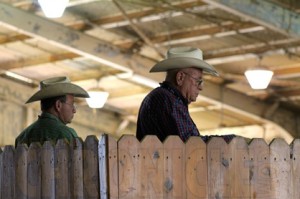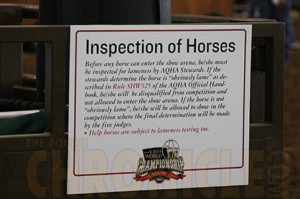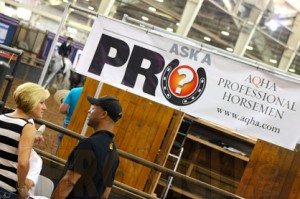AQHA’s Pete Kyle Explains New World Show “Obvious Lameness” Inspection Procedure and Other World Show Additions
By: Brittany Bevis
If you’re here at the 2014 AQHYA World Show in Oklahoma City, you may have noticed extra signage posted by each warmup pen explaining the new “Obvious Lameness” horse inspection procedure that applies to all horses planning to enter the show pen. The text of the sign reads as follows:
Inspection of Horses:
“Before any horse can enter the show arena, he/she must be inspected for lameness by AQHA Stewards. If the stewards determine the horse is ‘obviously lame’ as described in Rule SHW325 of the AQHA Official Handbook, he/she will be disqualified from competition and not allowed to enter the show arena. If the horse is not ‘obviously lame,’ he/she will be allowed to show in the competition where the final determination will be made by the five judges. Help horses are subject to lameness testing too.”
Because the stewards already check in horses for each class and monitor for prohibited tack and equipment, the new lameness inspection takes place at the same time. We watched as competitors were instructed to trot to an orange cone placed in the corner of the warm-up pen, trot around the cone, and return to the stewards.
To help understand what prompted this new pre-competition inspection criteria, we sought out the guidance of AQHA’s Executive Director of Shows and Judges, Pete Kyle.
“We’ve had some horses [try to] compete, occasionally, that we thought were obviously lame, and we thought they shouldn’t even be going in the arena for the judges to make that call,” Kyle says. “That’s why we’re doing it. It’s not a questionable lameness; it’s an obvious lameness.”
“The stewards are already checking bridles and horses, so it’s real simple. We check for legal equipment and then we check for the animal to be sound. It’s kind of an animal welfare thing. If they’re obviously lame, we’re not going to let them go into the arena. It’s not about [time being saved]. It’s about the animal, so he doesn’t have to go in and compete when he’s hurting. We’re going to carry it through all of our World Shows, the Select and Open/Amateur World Show too.”
In addition, any horse that will be entering the show pen, such as help horses for events like cutting or working cow horse, may be subjected to the inspection test as well. Thus far, Kyle says there as been an overwhelmingly positive exhibitor response to the new procedure.
“Everyone has been in favor of it,” he says. “We’ve had three different horses now that we’ve turned down, and everyone was real good about it. They were very understanding.”
“We’re not wanting to stop anybody from competing that the steward might say, ‘Well, that one looks a little lame.’ We’re leaving that part up to the judges. An obviously lame horse is the only one they’re allowed to call out.”
Also new to the Youth World Show this year is AQHA’s Ask a Pro booth, where AQHA Professional Horsemen make themselves available to answer questions for exhibitors and spectators. Typically, Professional Horsemen will stay at the booth for a minimum of three to four hours.
“We’re asking professionals to donate their time to help answer questions,” Kyle says. “It varies from questions about the patterns being run to the time schedule and anything that’s going on at the horse show all the way to any professional question that you need to ask about training. Like everything, there are certain times that are a lot busier than others, but they’ve all had people stop and ask questions that vary quite a bit.”
“There are two reasons why we’re doing this. Number 1 is that stewards were getting a lot of questions from exhibitors, so we’re trying to reduce the amount that have to go through the stewards. Also, if there is someone coming through the barn, like a spectator, that has a question about the horse show, they can get it answered. We didn’t try to single out any one discipline; we’ve just asked all professionals and they’ve stepped up.”
Kyle confirms that the Ask a Pro booth will be in the same location during the Amateur and Open World Championship Show this fall. If you’re a Professional Horsemen who might be interested in donating your time, please contact Ward Stutz, liaison for AQHA Professional Horsemen.
Also, at the Ask a Pro Booth, show-goers can pick up estimated time schedules and arena exercise time sheets for each day of the horse show in addition to handy pamphlets about prohibited equipment.
“I think AQHA has always been very proactive in animal welfare,” Kyle says. “For the last two years, they’re really being more proactive with trying to educate the exhibitors. With the Animal Welfare Commission, we’re trying to put out more information, like the pamphlets, to help educate and have better communication.”
One final addition to the Youth World Show worth mentioning is that non-competition horses are now being allowed on the show grounds. This benefits trainers and exhibitors who might be preparing to go to another horse show or simply would like a new market in which to exhibit their horses to the public.
“We have over 60 [non-competition] horses right now,” Kyle says. “We just got this passed two weeks ago, so not a lot of people know about it yet. I think it will be a big help for a lot of people at the World Show. A lot of people are going to other shows, like the NSBA World Show, and a lot of trainers have to bring horses that are not showing and then have to go off-grounds to ride and prepare them. It’s a lot easier if they’re here on grounds. We isolate them away from the World Show horses. There is separate stalling area in Barn 8.”
Many thanks goes to Pete Kyle for giving us the inside scoop about all of the new additions to the AQHA World Shows this year.













